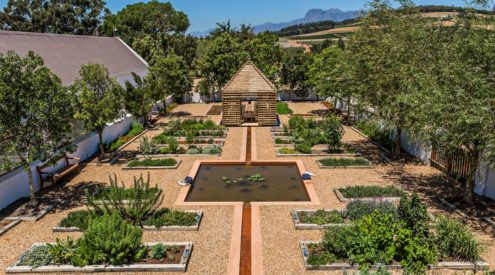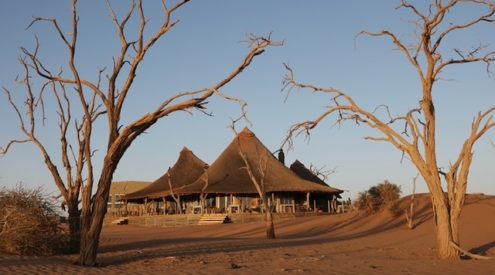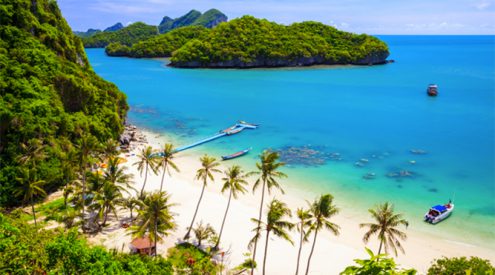Entering Paradise
It was early morning when my boyfriend James, his family and two significant others (including me) hopped aboard a ten-seater Cessna flying from an airstrip in Arusha to the Serengeti National Park. The novelty of such a small plane and its aerial view of the Ngorongoro Crater, Lake Manyara and Serengeti Plains kept my lips curled for most of the two-hour flight. When we landed, Erasto, our (personal) ranger from &Beyond, was waiting for us with Amarula coffees and an infectious smile.
After a two-hour drive through the park, we arrived at Klein’s Camp. The managers, Matt and Tiff, and ten other staff members were all waving and greeted us in Swahili, ‘Karibu! Karibu!’. Following a spree of jovial introductions, we were taken on a tour. This is where words start to fail.
The bar – with scattered leather armchairs and a circular fireplace at its centre – overlooks a bottle-green valley of untouched wilderness, sitting snugly between the Serengeti National Park and community owned Maasai land. The valley forms part of a 10 000 hectare private concession owned, for now, by &Beyond (renegotiation for the land will take place between Maasai and &Beyond representatives in a couple of years). A herd of around 40 elephants moved deliberately through the valley below, bulldozing acacias as they went. Three model giraffes followed in their wake. Maasai cowbells jingled sweetly in the distance, harmonised by the melodies of countless different birds. I sat – G&T in hand – mesmerised.
We ate dinner in the dining room to beat all dining rooms – six tables around a fireplace, overlooking a sliver of the same magnificent view as the bar. Tipsy and full, we were escorted to our bungalows (animals have been known to wander into the camp) where we climbed eagerly into our four-poster beds. Wrapped in perfect darkness, we dozed off to frog lullabies.
The privileges of privacy
With its 10 bungalows situated hundreds of kilometres away from the nearest town, Klein’s is as intimate as it is remote. Since we were the only visitors at the time, the concession felt like our private playground. Looking over the valley just before our first night drive, I felt like Simba seeing his kingdom for the first time. “˜Whatever the light touches is yours “¦’ Indeed, with 10 000 hectares of land at our fingertips, the light (and shadows) were ours to explore.
‘Within the concession we can drive wherever we wish. We don’t have to stick to the roads,’ Erasto told us with glee. With the Kruger National Park as my only frame of reference, the idea of going off road astounded me. Thankfully, Erasto is as much a conservationist as he is a ranger and I trusted his intimate knowledge of the valley, its tolerances and vulnerabilities. He wouldn’t do anything that could throw the natural system off balance.
Our first sighting was the herd of elephants we’d seen from the bar upon arrival. Erasto and Maisanga (our tracker) picked up on their anxiety almost immediately. ‘Something’s upsetting them. Let’s go see what it is.’ Erasto slipped into low range and directed our door-less Toyota Land Cruiser toward the enormous animals. As the experts suspected, two golden sets of lionesses ears peaked out from behind the shrubbery. Just as we spotted them, two of the three elephants shrieked through their trunks and moved menacingly toward the oversized cats. The lionesses slunk into the background, intelligent enough to avoid a messy confrontation. We moved the vehicle a little closer to admire the giants grazing, switching off the engine when they were about 10 m in front of us. To our right a small herd of buffalo gathered as the sky got darker and the crickets started their evening song. Surrounded by beasts, with a metal frame as our only curtain, I felt for sure that this was the show of a lifetime.
Day two saw us following in the footsteps of a fourteen-month-young leopard. The first leopard I’d seen in the wild, I struggled to come to grips with his pristine beauty and flawless physique. No doubt they are the supermodels of the feline empire – enticing yet aloof. Once again we went off road, following him along a riverbed, around an acacia grove and into an open grassy plain. True to form, he left us before we were ready to leave him, escaping up a hill that was too treacherous, even for a Toyota. With a seductive flick of his tail he disappeared, not to be seen again. As evening approached, Erasto and Maisanga surprised us with a very special sundowner. Atop a hill with a view of the valley (and a pride of lions on a nearby slope) Marco, our butler, had prepared a bonfire, laid out Maasai blankets and erected a bar. Maisanga smiled warmly as he registered our delight. We spent the evening and some of the night gaining precious insight into Maasai culture, Tanzanian politics and the lives of our three kind hosts.
Unlike the leopard, the lioness we saw the next morning was happy to indulge our curiosity, in spite of the three cubs she had in her care. Perhaps I imagined it, but she seemed more poised than any of the twelve females we saw during our stay. Maternal grace, I’d like to believe. For the better half of an hour, we sat mesmerised by the cubs as they roly-polied through the grass, tugging at mom’s tail and snuggling into her generous teats. We watched all of this from a few metres away.
A very special encounter
‘Touch them on the head,’ Maisanga whispered into my ear as a layoni (young Maasai boy) and three nditos (young girls) ran toward me, heads slightly bowed. They were, it seemed, eager to suss out the strangers in their midst. We had entered a small manyatta (grouping of Maasai huts) located just outside the concession boundary.
Maisanga explained that the 7.5 sq m huts are made and owned by the women. The frame is assembled from fine branches, interwoven with insect repellent leaves and twigs from the orange leaf croton. The frame is layered with a light layer of grass and then plastered with two centimetres of cow dung, carefully applied until the hut is considered complete. A small hole, about 10 cm in diameter, is left on one side, allowing smoke from the cooking fire to escape. The hut has two wooden beds covered in cowhides. One is small and completely enclosed with cow dung walls, leaving a small entrance for the occupant. This bed belongs to the woman of the house. Opposite, about 1.5 m away, is a larger bed that is only partially enclosed. Visitors other than the preferred guest (who shares the bed of the woman of the house) use this bedchamber. Only very small children share their mother’s bed, moving into separate “˜dormitory’ huts at the age of three or four. Young calves, in need of nightly protection, occupy an additional divided section.
We were invited into one of the women’s huts, where we drank sweet-tasting milk from a calabash and listened to snippets of Maasai history and culture, translated by Erasto. I was grateful for the fire’s warm glow, illuminating the curiosity-scrunched faces around me.
Two morans (Maasai warriors) who’d recently undergone circumcision were waiting for us when we got outside. They looked beautiful in their richly coloured robes, spears held high with all the confidence and pride of newly appointed kings. They agreed to us taking photographs of them, one shaking his ochre-stained braid from side to side with each click of my shutter.
‘Same spears. Same sticks. Same intimacy with their land and their cattle. Hundreds of years and nothing has changed. Perfect tradition!’ James’s words reran through my head as we headed out of the manyatta and back to the lodge. It was my first encounter with customs as ancient as that of the Maasai, and I was left wondering whether our curiosity had been intrusive? Nevertheless, I was happy to have learned something, however small, about a way of life so very different from my own.
Saying goodbye
Leaving Klein’s was difficult. Despite the two more &Beyond lodges that lay ahead, our drive to the airstrip was dampened by sadness. It wasn’t the luxury I was going to miss. The ten-to-one staff/guest ratio, regal rooms and five star meals are not the ingredients that make Klein’s so special. Magic rests in the place and its people. Erasto, with his intelligent wit and exceptional patience, and Maisanga, the soft-spoken Maasai, who seems to understand the beauty of humility more than most, had nestled quite unassumingly into my heart. So too, had the valley. Hopefully one day I will get to go back. There is a slim chance of me being a guest again, but who knows – they may need another housekeeper.

















